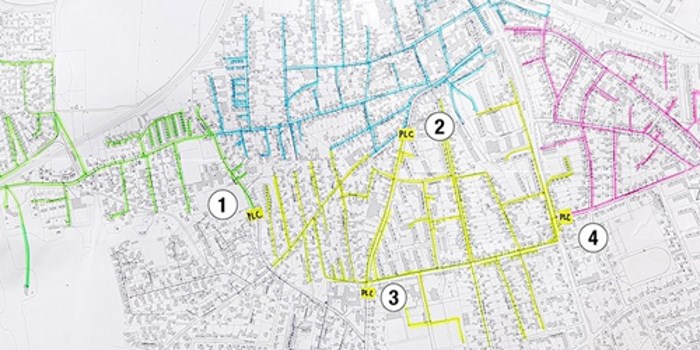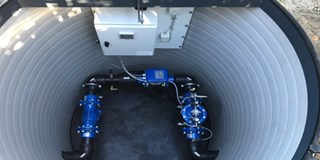^ The project map for AVK’s recent water distribution network rehab in Randers, Denmark. The pipe network is color-coded and numbered, indicating divisions into pressure zones.
Article by Daniel Sweet
___
Deciding on one definition for a “smart city” is difficult, but at their most basic, smart cities leverage data to increase the efficiency and reliability of infrastructure—from traffic grids to power lines to water distribution systems. It is in this last dimension of city management that valves are playing an increasingly important role. As Mr. Michael Hansen, Global Brand Manager at AVK Valves explained in a recent interview, pairing real-time data with smart control valves can improve the efficiency of water distribution while at the same time reducing pipeline repair costs.
“In cities all over the world, smart valves are helping to reduce non-revenue water (NRW), or all the water that a utility is producing but not getting paid for,” Mr. Hansen said. “NRW can come from leaks, theft, or inaccurate meters, and the amount of NRW in a given network has far reaching consequences, both in terms of energy consumption and water quality. In addition to reducing NRW, smart control valves help extend the lifetime of the pipe network, saving a small fortune in maintenance expenses. To understand how all of this comes together, it is important to understand how a traditional water distribution system works.”
Stabilisation
“One source of inefficiency in traditional water networks comes down to cycles of high and low pressure,” Mr. Hansen continued. “You can think about it quite simply: in the morning, everyone is waking up and going about all the routines of daily life. They are showering, brushing their teeth, making breakfast, and so on. During this period, when consumption is high, a city’s water distribution network experiences lower pressures.
When the population goes to work and the consumption decreases, the pressure rises to normal service pressure levels.”
“Then the cycle repeats in the evening—as people return home and begin cooking and doing laundry, the pressure drops again. These fluctuations over 24 hours will in the end stress the pipes, leading to NRW and to pipe bursts. In the case of the latter, this could come down to a lot of money—changing a pipe or valve buried 1.5m below ground, in the middle of the main road, blocking traffic—well you can imagine that it can become very expensive.”
Mr. Hansen went on: “The primary objective in smart water management is to stabilise pressure in the water distribution network. AVK attempts to solve this problem by establishing pressure zones, or district metered areas where we divide a whole water distribution network into smaller sections. At the inlet of every section we install chambers equipped with an intelligent control valve mounted alongside an ultrasonic water meter, which will then measure the volume entering the pressure zone. These smart control valves are used to maintain a constant pressure in each zone and eliminate fluctuations and the stresses they cause. Then, with the data gathered over time, you can start establishing parameters for the pressure adjustments within the zone.”
Intelligent operation
With Mr. Hansen’s initial explanation complete, the natural question becomes: what makes AVK control valves smart, and how do they work? “Essentially, the valves are connected to software that reads input from pressure and flow meters,” Mr. Hansen began. “This software allows the valves to adjust their position (and thus the pressure at the inlet of the zone they service) based on data coming from the far end of the zone. Compare this action to a normal control valve that has a set point, and the valve maintains the set point regardless of what’s happening around it. In the case of the smart valve then, you have pressure sensors sending signals back to the control valve and asking the valve to readjust according to demand.”
Mr. Hansen elaborated strike that the sensors that feed data to AVK’s smart control valves communicate on a number of protocols out-of-the-box, including Sigfox, LoRa-WAN or SMS, as examples. But depending on the type of network being used by the city or the water utility, the specifics of the software can be adjusted.
Furthermore, he explained that among other smart control valve options, the AVK offering is unique due to its AISI 316 stainless steel parabolic plug as well as the fact that the distribution block on the main valve has a modular design, allowing the customer to rebuild and change the function in-situ.
Savings
At the end of the day, those involved with the planning and management of a smart city want data of their own. And for those moments when the effectiveness of smart water distribution is assessed, Mr. Hansen is happy to share a straightforward formula. “It comes down to a simple rule of thumb. If you lower the pressure on a water distribution network by 10%, then you will save 10% of the lost water. If you lower the pressure by 30%, you will save 30% of the lost water. Furthermore, for each percentage you can lower the pressure of the pipeline, you will extend the lifetime by 0.2 years.”
“And if all those savings are not enough to convince a sceptic about the importance of smart water distribution, consider that an average pressure reduction of 30% will reduce the pipe-burst frequency by 50%. That comes down to big money. I like to use a case I had in Stockholm to illustrate this point. In that city, there was a certain 800mm pipe that cost the utility 1 million Swedish kronor each time it burst. In the year I was working on the case, the pipe burst 8 times. I will leave you to do the math.”



